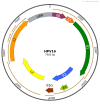HPV disease transmission protection and control
- PMID: 28357382
- PMCID: PMC5354572
- DOI: 10.15698/mic2016.09.530
HPV disease transmission protection and control
Abstract
Human papillomaviruses (HPVs) represent a large collection of viral types associated with significant clinical disease of cutaneous and mucosal epithelium. HPV-associated cancers are found in anogenital and oral mucosa, and at various cutaneous sites. Papillomaviruses are highly species and tissue restricted, and these viruses display both mucosotropic, cutaneotropic or dual tropism for epithelial tissues. A subset of HPV types, predominantly mucosal, are also oncogenic and cancers with these HPV types account for more than 200,000 deaths world-wide. Host control of HPV infections requires both innate and adaptive immunity, but the viruses have developed strategies to escape immune detection. Viral proteins can disrupt both innate pathogen-sensing pathways and T-cell based recognition and subsequent destruction of infected tissues. Current treatments to manage HPV infections include mostly ablative strategies in which recurrences are common and only active disease is treated. Although much is known about the papillomavirus life cycle, viral protein functions, and immune responsiveness, we still lack knowledge in a number of key areas of PV biology including tissue tropism, site-specific cancer progression, codon usage profiles, and what are the best strategies to mount an effective immune response to the carcinogenic stages of PV disease. In this review, disease transmission, protection and control are discussed together with questions related to areas in PV biology that will continue to provide productive opportunities of discovery and to further our understanding of this diverse set of human viral pathogens.
Keywords: HPV; animal papillomaviruses; codon modification; immunotherapy; pathogenesis; vaccines; viral oncogenesis.
Conflict of interest statement
Conflict of interest: I declare no conflict of interest in the preparation of this work.
Figures


Similar articles
-
Biology and pathological associations of the human papillomaviruses: a review.Malays J Pathol. 1998 Jun;20(1):1-10. Malays J Pathol. 1998. PMID: 10879257 Review.
-
Recent advances in preclinical model systems for papillomaviruses.Virus Res. 2017 Mar 2;231:108-118. doi: 10.1016/j.virusres.2016.12.004. Epub 2016 Dec 9. Virus Res. 2017. PMID: 27956145 Free PMC article. Review.
-
Pathogenesis of infection by human papillomavirus.Curr Probl Dermatol. 2014;45:47-57. doi: 10.1159/000355963. Epub 2014 Mar 13. Curr Probl Dermatol. 2014. PMID: 24643177 Review.
-
Minor Capsid Protein L2 Polytope Induces Broad Protection against Oncogenic and Mucosal Human Papillomaviruses.J Virol. 2018 Jan 30;92(4):e01930-17. doi: 10.1128/JVI.01930-17. Print 2018 Feb 15. J Virol. 2018. PMID: 29212932 Free PMC article.
-
Animal models of papillomavirus pathogenesis.Virus Res. 2002 Nov;89(2):249-61. doi: 10.1016/s0168-1702(02)00193-4. Virus Res. 2002. PMID: 12445664 Review.
Cited by
-
Sexual practices and HPV infection in unvaccinated young adults.Sci Rep. 2022 Jul 20;12(1):12385. doi: 10.1038/s41598-022-15088-8. Sci Rep. 2022. PMID: 35859090 Free PMC article.
-
NK Cell Regulation in Cervical Cancer and Strategies for Immunotherapy.Cells. 2021 Nov 10;10(11):3104. doi: 10.3390/cells10113104. Cells. 2021. PMID: 34831327 Free PMC article. Review.
-
HPV Infection Prevalence, Vaccination-Related Knowledge, Attitudes, and Barriers Among Women Aged 30-64 in Shenzhen, China: A Cross-Sectional Study.Vaccines (Basel). 2025 May 25;13(6):561. doi: 10.3390/vaccines13060561. Vaccines (Basel). 2025. PMID: 40573892 Free PMC article.
-
Willingness to get HPV vaccination among female university students in Kuwait and its relation to vaccine conspiracy beliefs.Hum Vaccin Immunother. 2023 Dec 31;19(1):2194772. doi: 10.1080/21645515.2023.2194772. Epub 2023 Apr 2. Hum Vaccin Immunother. 2023. PMID: 37005342 Free PMC article.
-
Innate immunity and HPV: friends or foes.Clinics (Sao Paulo). 2018 Oct 11;73(suppl 1):e549s. doi: 10.6061/clinics/2018/e549s. Clinics (Sao Paulo). 2018. PMID: 30328949 Free PMC article.
References
Publication types
Grants and funding
LinkOut - more resources
Full Text Sources
Other Literature Sources
